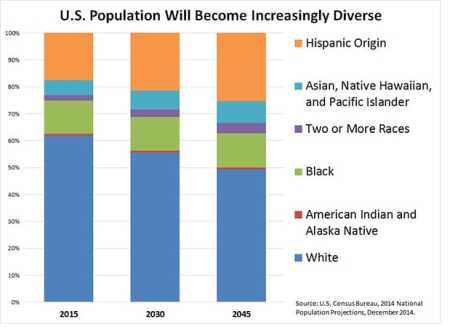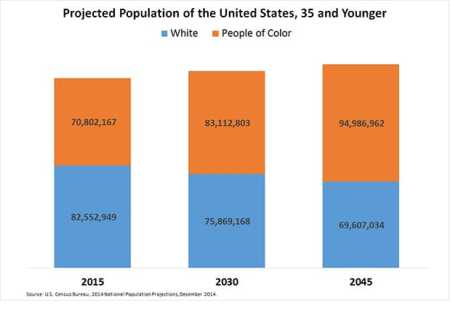The United States is undergoing a “pivotal period of demographic change” that will be as important to the 21st century as the baby boom was to the 20th century, according to William H. Frey, demographer for the Brookings Institution and author of Diversity Explosion: How New Racial Demographics Are Remaking America.
Projections by the U.S. Census Bureau, released in December 2014, show population growth of 38 million between 2015 and 2030, with another 30 million added between 2030 and 2045. The country, however, is in the midst of a postrecession baby bust. According to the National Center for Health Statistics, the 2013 birth rate was at a record low, calling these growth projections into question.
But the faces of those in America’s younger generations look substantially different from those of the country’s elders. Today, there is no majority race for children under five. Multiracial marriage is climbing and, according to Frey, has reached one out of seven marriages. In addition, the census bureau’s projections show that the white, non-Hispanic population will start to decline in absolute terms in the next ten years.
Frey is the first to point out that the United States “is lucky to have this trend” of a growing population, in contrast with other countries with shrinking or aging workforces, but he is equally emphatic when he concludes that “the future well-being of seniors and the nation as a whole depends on the ability of today’s youth to succeed in tomorrow’s labor force.”
Commenting on the Diversity Explosion during a December event at the Brookings Institution, Ronald Brownstein, author and political journalist, is less optimistic. He sees the country in a worsening “cultural generation gap” divided into “the brown and the gray.” He worries that for much of America, the diversity explosion is “just something that is happening on TV.” More than 100 percent of the growth in the workforce between now and 2030 (and beyond) will come from today’s racial minorities, he observes.
Immigration also will contribute to America’s changing demographic landscape, but Frey’s numbers show that “the diversity explosion is going to happen regardless of what happens with immigration.” Simple demographic rules apply: aging populations shrink; young populations grow. The age profile of the white population in the United States is similar to the aging and shrinking populations of Europe and Japan. The natural increase that will keep the country growing comes, for the most part, from the country’s relatively youthful Hispanic populations.
The diversity explosion is geographic as well as demographic. The old story of racial minorities concentrated in large cities is no longer the case. The burgeoning Hispanic populations have dispersed. Frey found 222 metropolitan areas—large, medium, and small—where Hispanic populations are either more concentrated or growing faster than the national average; in 44 metropolitan areas both applied.
Asian populations, a group Frey describes as “the newest minority surge,” while still concentrated on America’s coasts, are also finding their way to southern and heartland regions like Atlanta, Phoenix, and Indianapolis. For black Americans, however, regional reconcentration is the dominant trend. African Americans are returning to their roots in the South, flocking to Atlanta, Dallas, Houston, Miami, Washington, and Charlotte metropolitan areas.
Within these growing metropolitan regions, suburbs are attracting an increasingly diverse population. Hispanic population growth is fueling population increases in both cities and suburbs. African Americans, in what Frey calls “black flight,” are leaving cities for suburbs. Cities such as Chicago, New York, and Los Angeles are losing their black populations. Even in the southern regions attracting African Americans, they are more often than not heading for the suburbs. By the 2010 census, a majority of metropolitan Asians, Hispanics, and African Americans resided in suburbs.
Reproduction drives population growth; digging deeper into the census bureau’s methodology reveals who the bureau thinks will be producing the babies that will be America’s future growth. American-born groups “were below replacement in 2011” and only “foreign-born Hispanics and foreign-born non-Hispanic others are projected to have fertility levels that exceed replacement at any point” between now and 2060. The fuel that drives the engine of natural increase in the United States will be the life experiences and choices of women born in Latin America, the Caribbean, and Africa.
America’s baby bust has yet to hit bottom after the pre-recession high in births in 2007. Year-over-year declines continued in 2012 and 2013. Some of the bust is certainly reproduction delayed, as young adults take longer to believe in their economic security.
Improved contraceptive technologies and access to higher-quality health care will just as certainly affect the height of the rebound in number of births. The most recent numbers, covering a period from 2006 to 2010, show that 37 percent of births in the United States resulted from unintended pregnancies. In 2012, the American College of Obstetricians and Gynecologists issued an opinion that long-acting, reversible contraceptive methods should be “the first-line recommendations for all women and adolescents.” At the same time, the Affordable Care Act expanded access to preventive services, including contraception. A future where the vast majority of babies are planned seems within sight.
The built environment has always been the stage on which America’s complex racial dynamics play out. The built environment shapes people’s understanding of home, neighbor, customer, colleague, teammate, employee, citizen, taxpayer, mentor, and friend.
Business models that primarily attract tenants, customers, or workers who are predominantly white and under 35 will be facing shrinking markets. Government policies affecting immigration, education, workforce development, and the support of young families will also come to the fore.
In addition, the real estate industry should be mindful that census bureau categories do not necessarily reflect how people see themselves, nor how they will see themselves in the future. One hundred years ago, the census bureau listed “Italian” as a race. The bureau first added “two or more races” for the count in 2000.
In a country where everyone is a racial “minority” and where families themselves are becoming more diverse, even the language used to describe identity will evolve. For Frey, he sees hope in an old term: America as a “melting pot.” Demographics may be destiny, but whether America is a “melting pot,” a “tossed salad,” or some other new fusion food metaphor will be up to the choices of its people.
Sarah Jo Peterson is senior director, policy, for the Urban Land Institute.






